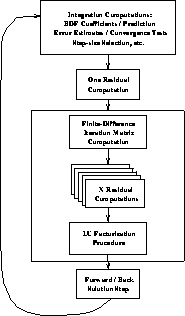




Next: Single Integration Step
Up: 9.6.4 Concurrent Formulation
Previous: 9.6.4 Concurrent Formulation
Next, we turn to Equation 9.11's (that is, IVP's)
concurrent numerical solution via the DASSL algorithm. We cover the
major computational steps in abstract, and we also describe the generic
aspects of proto-Cdyn in this connection. In the subsequent section,
we discuss issues peculiar to the distillation simulation.
Broadly, the concurrent solution of IVP consists of three block
operations: startup, dynamic simulation, and a cleanup phase.
Significant concurrency is apparent only in the dynamic simulation
phase. We will assume that the simulation interval requested generates
enough work so that the startup and cleanup phases prove insignificant
by comparison and consequently pose no serious
Amdahl's-law bottleneck. Given this assumption, we
can restrict our attention to a single step of IVP as illustrated
schematically in Figure 9.15.

Figure 9.15: Major Computational Blocks of a Single Integration Step.A single step in the integration begins with a number of BDF-related
computations, including the solution ``prediction'' step. Then,
``correction'' is achieved through Newton iteration steps, each involving a
Jacobian computation, and linear-system solution (LU factorization plus
forward- and back-solves). The computation of the Jacobian in turn relies upon
multiple independent residual calculations, as shown. The three items
enclosed in the rounded rectangle (Jacobian computation-through at most N
Residual computations-and LU factorization) are, in practice, computed less
often than the others-the old Jacobian matrix is used in the iteration loop
until convergence slows intolerably.
In the startup phase, a sequential host program interprets the user
specification for the simulation. From this it generates the concurrent
database: the templates and their mutual interconnections, data needed by
particular templates, and a distribution of this information among the
processes that are to participate. The processes are themselves spawned and
fed their respective databases. Once they receive
their input information, the processes rebuild the data structures for
interfacing with Concurrent DASSL, and for
generating the residuals. Tolerances and initial derivatives must be
computed and/or estimated. Furthermore, in each process column, the
processes must rendezvous to finalize their communication labelling for
the transmission of states and nonstates to be performed during the
residual calculation. This provides the basis for a reactive,
deadlock-free update procedure described below.
The cleanup phase basically retrieves appropriate state values and returns
them to the host for propagation to the user. Cleanup may be
interspersed intermittently with the actual dynamic simulation. It provides
a simple record of the results of simulation and terminates the concurrent
processes at the simulation's conclusion.
The dynamic simulation phase consists of repetitive prediction and correction
steps, and marches in time. Each successful time step requires the solution
of one or more instances of Equation 9.12-additional time steps
that converge but fail to satisfy error tolerances, or fail to converge
quickly enough, are necessarily discarded. In the next section, we cover
aspects of these operations in more detail, for a single step.





Next: Single Integration Step
Up: 9.6.4 Concurrent Formulation
Previous: 9.6.4 Concurrent Formulation
Guy Robinson
Wed Mar 1 10:19:35 EST 1995





